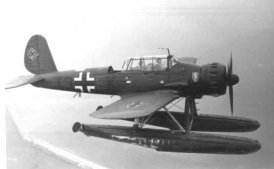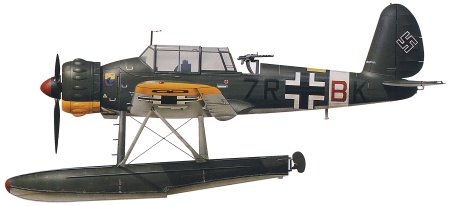
Arado Ar 196
The Arado-196 was a highly successful seaplane design which served as a reconnaissance plane for the Kriegsmarine. Although most units had operated from coastal air bases, but the aircraft is best known as the catapult launched scout plane of the German navy.
Design work began in 1936 with the Reichs Air Ministry issuing a specification for a new floatplane to replace the obsolete Heinkel-50, then in service with the fleet. By the onset war, trials for the Arado-196 had just entered its completion stage. Later, history would show that the Arado-196 was destined to become one of the finest floatplane designs of the war. By wars end, several variants had been produced and it was also the last fighting floatplane to be built in Europe. The final version had upgraded armament of twin MG81 machine-guns in the rear cockpit.
Beginning with the Admiral Graf Spee, all the other German capital ships subsequently received the Arado-196, including the battlecruiser Gneisenau and the famed Bismarck. This little plane enabled the capital ships to scout ahead at distances of over a few hundred kilometers, increasing the effectiveness of the raiding party. When an Allied convoy is sighted, the convoy location and any accompanying warships is radioed back to the mother ship, which would then steam to intercept.
In addition to reconnaissance, the Arado-196 also served a multitask role, including sea-rescues, coastal patrols, inserting agents behind enemy coastal lines, and even in combat situations. With its heavy armament of two forward firing 20 mm cannons, twin 7.92mm rear machine guns and two 50-kg bombs, the Arado-196 can intercept and attack lone Allied aircraft. In 1940, two Arados managed to attack a crippled British submarine, inflicting enough damage to prevent it from submerging, and enabling the Kriegsmarine to close in for the capture. Another noteworthy mention is in 1941, when the Bismarck launched its Arado-196 to drive off a shadowing RAF Catalina.
Constructed primarily of metal framework, the Arado-196 was of modern design utilizing an enclosed cockpit and twin floats to aid in its stability. The floats were fitted with rudders and also served as extended fuel tanks and storage space for other emergency provisions. The extended fuel tanks enabled the scout plane to remain in the air for up to four hours at a time, which for scout planes was a more important factor than long range.
A nine cylinder BMW radial engine producing a high power output of 960-hp also placed the Arado-196 as the fastest in its class. Coupled with a sound airframe design, it also had the highest ceiling height compared to its British and American counterparts. This is of innumerable advantage, as a greater ceiling height enabled the crew to scout over greater distances.
The Arado-196 served in all maritime theaters of war with operations ranging from the Arctic to the Black Sea. It also served with coastal units in Norway, Denmark, Bulgaria, Finland, Romania and the Mediterranean.
The Arado-196 was built by Fokker and SNCA.
 |
 |
 |
| The floats created much air resistance and limited performance on floatplanes. The Arado-196 was initially fitted with a single float, but later trials replaced it with twin floats due to instability on the water. |
Most Arado-196 were operated from coastal land bases where they carried out coastal patrols and anti-submarine patrols. |
The enclosed cockpit was a modern design for a floatplane of the pre-war period. Also note the rudders attached at the rear of the floats. |
|
Arado Ar 196 (Technical Specification) |
| Role |
Two-seat shipboard and coastal patrol aircraft |
| Manufacturer |
Arado |
| Maximum Speed |
310 kmh (193 mph) |
| Combat radius |
1,070 km (665 miles) |
| Ceiling |
7,000 meters (23,000 feet) |
Weight
Empty
Maximum Takeoff |
2,990 kg (6,592 lbs)
3,730 kg (8,223 lbs) |
Dimensions
Wingspan
Length
Height
Wing Area |
12.40 meters (40 ft 8 in)
11.00 meters (36 ft 1 in)
4.45 meters (14 ft 7 in)
28.40 square meters (306 sq ft) |
| Engines |
One BMW 123K nine-cylinder radial which provides 716-kW (960-hp) |
| Armament |
Two 20 mm (0.79 in) cannon in the wings
One or two 7.92 mm (0.31 in) guns in the rear cockpit and front fuselage
Two 50 kgs (110 lbs) of bombs |
Photo Gallery
Click here to submit your photo
| Have A Passion For Aircraft? |
Subscribe to our 14 series FREE newsletter
delivered weekly on World War 2 Aircraft factfile... |
| NB:- We hate spam as much as you do, so your email address will NEVER be shared with or sold to anyone else. That's a Guarantee. |
|
|






